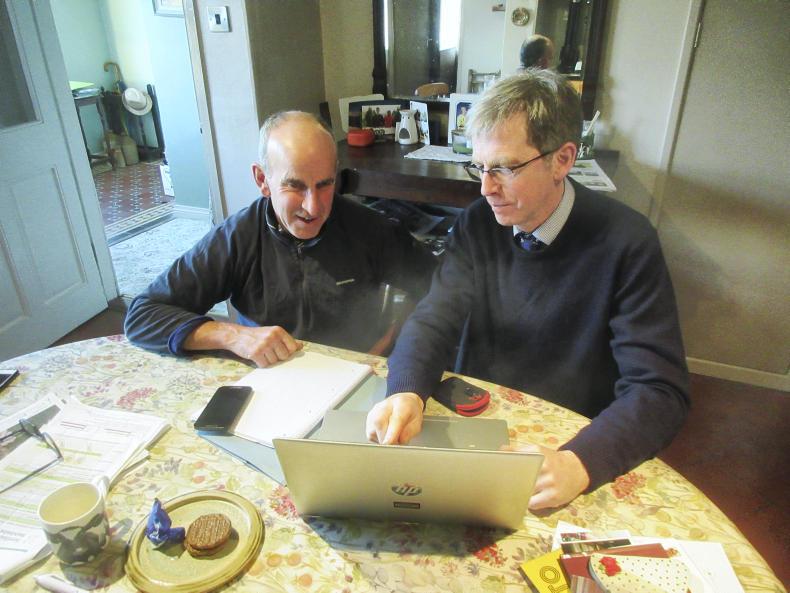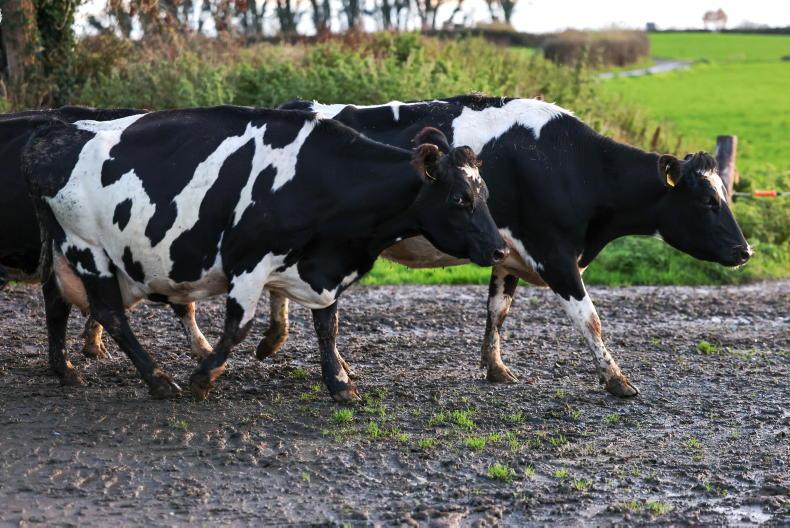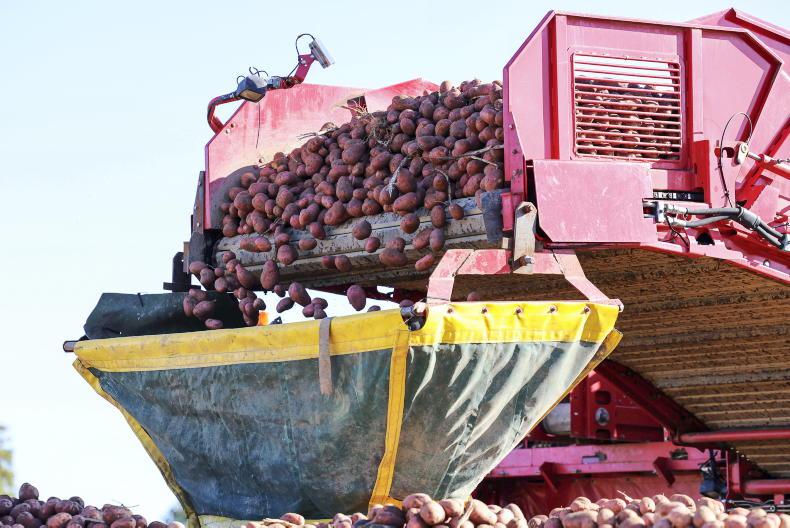Regular soil analysis and the development of nutrient management plans is paying dividends on Dairylink Ireland farms. All participants in phase two of Dairylink carried out an extensive soil sampling programme at the start of the project in late 2018. A nutrient management plan based on the soil analysis results was then developed for each farm.
In the last few weeks, the project farmers have taken more soil samples to review the impact of the nutrient plans on soil pH, phosphorus (P) and potassium (K) indices. These three measures have been identified as key performance indicators for influencing soil fertility and grass growth.
Soil pH has been shown to have a major impact on the uptake of nitrogen (N), P and K by grass and its resultant growth. A target of pH 6.0 to 6.5 is generally identified as optimal for grass growth.
On Stephen Wallace’s farm near Seaforde, Co Down, an initial review of samples taken in 2018 showed that around 40 % of the area sampled had a soil pH less than 5.8.
Improving soil pH was highlighted as a priority for Stephen’s farm and around 10ha (25 acres) received an application of lime at a rate of 5t to 6 t/ha (2t to 2.5t/acre).
As Table 1 shows, the result is that only 14 % of the area sampled in January 2020 had a soil pH less than 5.8. Stephen also commented that he has since noticed that the fields with a low soil pH do not appear to be as productive as other fields in terms of grass growth, even though levels of P and K in the reports for those fields appear to be adequate.
He plans to continue identifying fields that require additional lime this year through a reseeding programme, as well as general lime applications to grassland.
Soil P and K
P is important for grass growth in terms of root growth and tillering. However, additional P applications over and above plant requirements have negative environmental consequences. This means that the review of soil P requirements and subsequent applications is of vital importance for both agricultural output and the environment.
Applications of K are also important for strengthening the plant against external stresses. The optimum amounts of P and K to be applied for grazing and silage will depend on existing levels in the soil and what is also being applied in terms of organic manure. The soil index system for P and K is slightly different in Northern Ireland (NI) than the system used in the Republic of Ireland.
In the NI system, intensive grassland soils with a P and K index 0 and 1 are deficient, index 2- is a slight deficit, 2+ is optimal and index 3 and over is above optimal. In the Republic of Ireland, soil index 1 is classified as very low, index 2 is low, index 3 is medium and index 4 is sufficient or excessive.
Soil P and K indices were reviewed on Stephen’s farm and a distribution of P and K levels are illustrated in Figures 1 and 2.
Initial analysis has indicated that around 28 % of the area sampled in 2020 had a soil P index greater than 3. In addition, 64 % of the area sampled recently had a soil K index greater than 2+. This has implications for determining nutrient requirements for grass growth.
A soil analysis report may give general recommendations about levels of N, P and K required for grass growth for grazing and silage production. However, it may not give specific information on what type and amount of inorganic fertiliser to apply.
However, this information can be obtained by entering soil analysis results into the DAERA online crop nutrient calculator programme, along with planned organic manure applications.
This will determine the optimum type and amount of inorganic fertiliser to be applied to yield the optimum response. It will be carried out using the results from Stephen’s latest soil analysis report to identify any further revisions which may be required to his nutrient management plan.
Fertiliser plans
Plans are in place to apply slurry to silage fields this week, ground and weather conditions permitting.
Stephen is also considering the purchase of urea and possibly some protected urea to be applied at 30kgN/ha within the next few weeks to build up grazing covers with a view to turning cows out to grass in mid- to late March. Other chemical fertilisers will be purchased when the nutrient management plan for the farm is completed.
Key points
Collect any remaining soil samples for analysis immediately.Identify fields on your analysis report which require additional lime applications.Use DAERA’s online crop nutrient calculator programme to determine the optimum nutrient applications for your farm.
Regular soil analysis and the development of nutrient management plans is paying dividends on Dairylink Ireland farms. All participants in phase two of Dairylink carried out an extensive soil sampling programme at the start of the project in late 2018. A nutrient management plan based on the soil analysis results was then developed for each farm.
In the last few weeks, the project farmers have taken more soil samples to review the impact of the nutrient plans on soil pH, phosphorus (P) and potassium (K) indices. These three measures have been identified as key performance indicators for influencing soil fertility and grass growth.
Soil pH has been shown to have a major impact on the uptake of nitrogen (N), P and K by grass and its resultant growth. A target of pH 6.0 to 6.5 is generally identified as optimal for grass growth.
On Stephen Wallace’s farm near Seaforde, Co Down, an initial review of samples taken in 2018 showed that around 40 % of the area sampled had a soil pH less than 5.8.
Improving soil pH was highlighted as a priority for Stephen’s farm and around 10ha (25 acres) received an application of lime at a rate of 5t to 6 t/ha (2t to 2.5t/acre).
As Table 1 shows, the result is that only 14 % of the area sampled in January 2020 had a soil pH less than 5.8. Stephen also commented that he has since noticed that the fields with a low soil pH do not appear to be as productive as other fields in terms of grass growth, even though levels of P and K in the reports for those fields appear to be adequate.
He plans to continue identifying fields that require additional lime this year through a reseeding programme, as well as general lime applications to grassland.
Soil P and K
P is important for grass growth in terms of root growth and tillering. However, additional P applications over and above plant requirements have negative environmental consequences. This means that the review of soil P requirements and subsequent applications is of vital importance for both agricultural output and the environment.
Applications of K are also important for strengthening the plant against external stresses. The optimum amounts of P and K to be applied for grazing and silage will depend on existing levels in the soil and what is also being applied in terms of organic manure. The soil index system for P and K is slightly different in Northern Ireland (NI) than the system used in the Republic of Ireland.
In the NI system, intensive grassland soils with a P and K index 0 and 1 are deficient, index 2- is a slight deficit, 2+ is optimal and index 3 and over is above optimal. In the Republic of Ireland, soil index 1 is classified as very low, index 2 is low, index 3 is medium and index 4 is sufficient or excessive.
Soil P and K indices were reviewed on Stephen’s farm and a distribution of P and K levels are illustrated in Figures 1 and 2.
Initial analysis has indicated that around 28 % of the area sampled in 2020 had a soil P index greater than 3. In addition, 64 % of the area sampled recently had a soil K index greater than 2+. This has implications for determining nutrient requirements for grass growth.
A soil analysis report may give general recommendations about levels of N, P and K required for grass growth for grazing and silage production. However, it may not give specific information on what type and amount of inorganic fertiliser to apply.
However, this information can be obtained by entering soil analysis results into the DAERA online crop nutrient calculator programme, along with planned organic manure applications.
This will determine the optimum type and amount of inorganic fertiliser to be applied to yield the optimum response. It will be carried out using the results from Stephen’s latest soil analysis report to identify any further revisions which may be required to his nutrient management plan.
Fertiliser plans
Plans are in place to apply slurry to silage fields this week, ground and weather conditions permitting.
Stephen is also considering the purchase of urea and possibly some protected urea to be applied at 30kgN/ha within the next few weeks to build up grazing covers with a view to turning cows out to grass in mid- to late March. Other chemical fertilisers will be purchased when the nutrient management plan for the farm is completed.
Key points
Collect any remaining soil samples for analysis immediately.Identify fields on your analysis report which require additional lime applications.Use DAERA’s online crop nutrient calculator programme to determine the optimum nutrient applications for your farm. 









SHARING OPTIONS